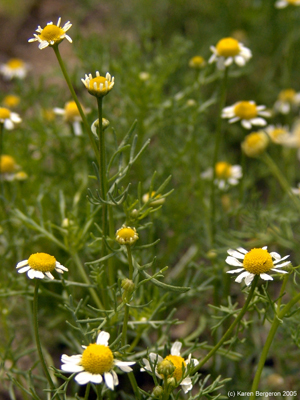Matricaria recutita
| See Also | Botanical Monographs |
|---|
Chamomile (Matricaria recutita) is used both internally and externally. It is used to treat pediatric colic and teething and for digestive and skin conditions. To explore the characteristics, medicinal uses and prescribing considerations of this herb in more detail, check out the references indicated.[1], [2]
Contents
Characteristics
AKA Chamomilla recutita, M. chamomilla
- Common Names: German chamomile, Single chamomile, Ground apple, Hungarian chamomile, Pinheads, Wild chamomile, Sweet false chamomile
- Family: Compositae/Asteraceae
- Habitat: Matricaria recutita is native to Europe and is now naturalized in North America and elsewhere.
- Parts Used: Flowers (preferably picked a few days before opening)
- Constituents: Volatile oils (active constituent), Apigenin and other flavonoids (active constituents), Sesquiterpene lactones, coumarins, phenolic acids, dicyclic ethers, mucilage
- Medicinal Actions: antispasmodic, anti-inflammatory, anti-inflammatory gastrointestinal, mild sedative, nervine, carminative, stomachic, antiemetic, antirheumatic, analgesic, antiseptic, vulnerary, diaphoretic, mild antimicrobial, anticatarrhal, antiulcer, aromatic, bitter, decongestant, emmenagogue, tonic
Uses
Historical Uses:
Helped Peter Rabbit recover from indigestion after a bout of over-eating; one of nine sacred herbs given to the world by the god Woden. Also used for painful menses.
Medicinal Uses:
Internal
- Gastrointestinal discomfort, flatulence, dyspepsia, loss of appetite, Irritable Bowel Syndrome, peptic ulcers, gastritis, diarrhea.
- Other Conditions
External
- Inflammatory skin conditions, cuts, bruises, hemorrhoids, pruritic irritation (compress or ointment), eye strain (eyewash).
- Canker sores, irritation of the gums and mouth, aphthous ulcers, gingivitis, sore throats (gargle).
- Phlegm, hayfever, asthma, bronchitis (steam inhalation).
Homeopathically this remedy is referred to as Chamomilla.
Prescribing Considerations
The information provided is intended to augment the treatment from a naturopathic doctor or other trained medical professional. Although most herbs are generally safe, it is recommended that you avoid self-prescribing especially when there is an underlying ongoing medical condition, if you are on any prescription medications or if you are pregnant or breastfeeding.
Formulations and Preparation
- Infusion - 2 tsp/cup three to four times daily
- Tincture - 1-4mL (1:5, 40%) three times daily or 7-14mL (1:5, 50%) three times daily
- Oil - 2-3 drops of essential oil in hot water basin for steam inhalation
- Eyewash - 5-10 drops in warm water
- To encourage a baby to sleep - 1-2 cups strained infusion in bath water
Safety
The safety and prescribing considerations for Chamomile include: [3], [4]
- Generally regarded as safe.
- Side-effects are possible contact dermatitis, vomiting (in very high doses)
- Cautions and Contraindications: individuals with known allergy to members of the Asteraceae/Compositae family, pregnancy (whole plant, empirical; excessive doses, speculative)
- Drug-Herb Interactions. [2]
- Non-heme Iron - Reduced absorption (human study)
- Warfarin - Potentiated (speculative)
- Benzodiazepines and Opiate Withdrawal - Adjuvant to (empirical)
References
- ↑ Boon Heather, Smith Michael (2009) 55 Most Common Medicinal Herbs: The Complete Natural Medicine Guide Second Edition Institute of Naturopathic Education and Research, CCNM Toronto.
- ↑ 2.0 2.1 Godfrey Anthony, Saunders Paul, Barlow Kerry, Gowan Matt (2011) Principles and Practices of Naturopathic Botanical Medicine, Advanced Botanical Medicine. V3 CCNM Press, Toronto.
- ↑ Stargrove Mitchell Bebell, Treasure Jonathan, McKee Dwight L (2008) Herb, Nutrient and Drug Interactions: Clinical Implications and Therapeutic Strategies.
- ↑ Brinker Francis (1997) Herbal Contraindications and Drug Interactions: Plus Herbal Adjuncts With Medicines, 4th Edition Eclectic Medical Publications.
, Clinical Implications and Therapeutic Strategies
